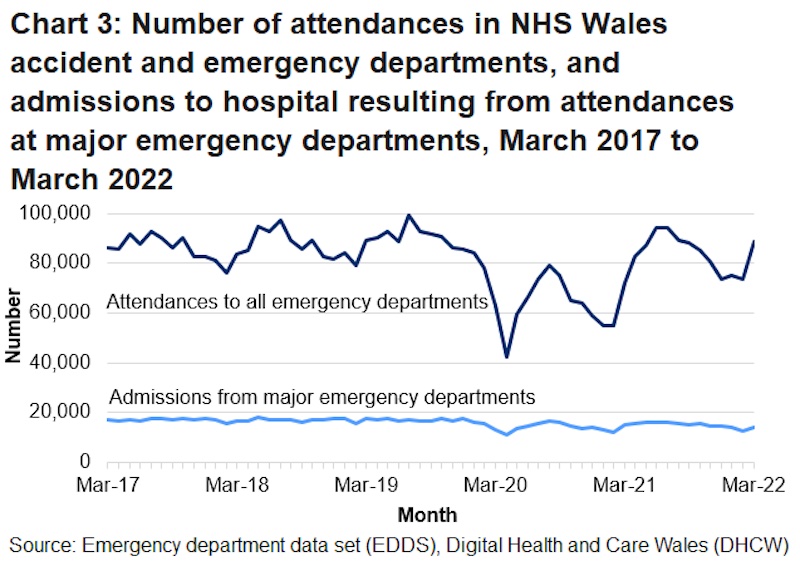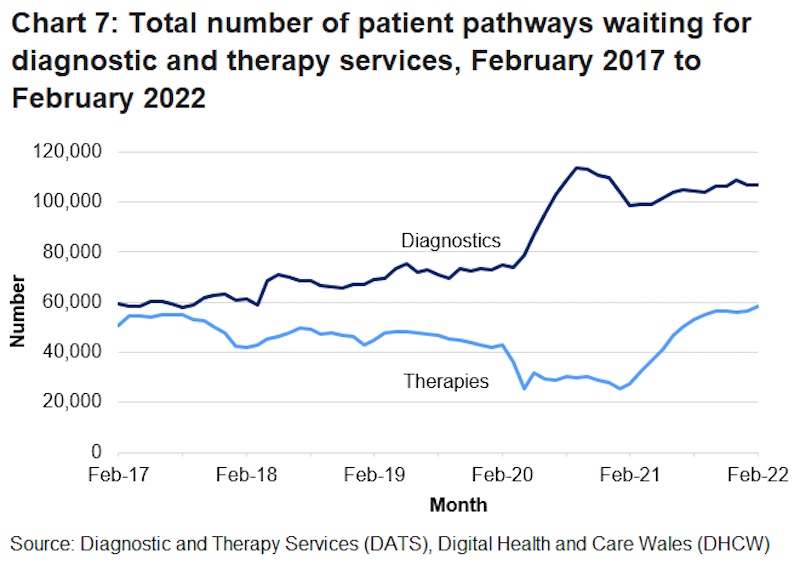“Lowest performance on record” against four hour target for emergency departments in Wales

The number of people accessing emergency departments “sharply increased” in Wales last month, new figures have revealed.
Data released today by the Welsh Government also shows the highest number of daily attendees since September 2021.
Waiting times at A&E have continued to worsen with March seeing the lowest performance on record against the four and 12 hour waiting targets.
In March there were almost 89,000 attendances to all NHS Wales emergency departments. This is an average of 2,858 emergency department attendances per day; 232 more attendances per day on average than in the previous month, and 536 more than in the same month last year.
The Welsh Government target is for 95 per cent of patients spending less than 4 hours in emergency departments from arrival until admission, transfer or discharge.
However the average time spent in emergency departments also reached the longest on record, at three hours and eight minutes.

In Wrexham just over 46 per cent of the 4,819 attendees seen within a four hour period.
However Ysbyty Glan Clwyd saw the worst waiting times in North Wales against the four hour target, with 44.1 per cent compared to to 52 per cent at Ysbyty Gwynedd.
Locally 64.3 per cent were seen within eight hours and 76.6 per cent within 12 hours.
Pressure on the Welsh Ambulance Service continued to grow last month, with the number of emergency calls increasing.
However the number, and proportion, of life threatening calls remains high and the performance target continues not to be met.
In March, almost 39,000 emergency calls were made to the ambulance service – an average of 1,256 calls per day. This is an increase of 28 (2.3 per cent) calls on average per day than the previous month and 47 (3.9 per cent) more calls on average per day than the same month last year.

The number of immediately life-threatening calls also increased last month, with an average of 116 made per day.
But despite a 65 per cent target of attending red calls within eight minutes, just 51.1 per cent of calls were responded to within that time frame.
This is 11.4 per cent lower than the same time last year.
Today’s data also reveals there are 691,885 people across Wales who are now waiting to start treatment.
Of these 369,510 have been waiting up to 26 weeks, 70,728 between 26 and 36 weeks and 251,647 over 36 weeks.
This is the highest since comparable data was first collected in 2011
In Betsi Cadwaladr University Health Board there are 152,657 people waiting to start treatment – 58,988 of which have been waiting longer than 36 weeks.
However the number of patient pathways waiting, those waiting longer than the target time and average waiting times for diagnostic services all decreased in February.

Today’s figures have been described as “immensely worrying” by Rhun ap Iorwerth MS, Plaid Cymru’s spokesperson for Health and Care.
He said:”Frontline staff continue to work flat out, but leadership needs to come from the top and that’s why we need to see the Welsh Government’s plan to reduce waiting times in all sectors of care, treatment and diagnostics as a matter of urgency.
“Any slight improvement in waiting times is to be welcomed, but almost 44,000 patients were still waiting longer than the target time for diagnostics, which is twelve times greater than before the pandemic.
“Recovering from Covid and reducing these waiting lists is an enormous mountain to climb. A recovery plan must have a clear focus on prevention, not just patient through-put. Publication of the plan has been pushed back several times, but cannot be delayed further.
“We also need a Cancer action plan to deal specifically with diagnosis and treatment. A year has passed since the Quality Statement but there’s still no implementation plan.”
Commenting, Welsh Conservative and Shadow Health Minister Russell George MS said: “After Labour’s management of the NHS hit new lows as waiting times reached new heights last autumn, the people of Wales expected things to get better from there, not worse.
“But here we are on the verge of NHS waiting lists breaking its own record on a monthly basis for two years, A&E waits at their worst-ever, with ambulance responses not far behind – all the more dispiriting when things are getting better in England.
“Every one of these cases is more than a mere statistic – it is a person languishing in pain wondering how the public services they pay for have been so badly mismanaged. That person in one in every five: family, friends, colleagues – you will know one of them if you are not one of them yourself.”

In a statement the Welsh Government said that coronavirus is continuing to impact waiting times and staffing levels – with infection control measures affecting the “level of activity health board can undertake”.
The spokesperson said: “Despite this, the number of patient pathways waiting over 8 weeks for diagnostic tests decreased by 10% compared to January 2022 and by 30% compared to the high point of May 2020. All health boards have shown an improvement.
“Although some people continue to wait longer for treatment than we would like, with the over 36 week position increasing again in February, this increase was the second smallest month-on-month increase since the start of the pandemic. In addition, five health boards showed a decrease in their over 36 week waits, an improvement from January, when only two health boards showed an improvement.
“There are several factors contributing to make it difficult for urgent and emergency care services to deliver timely care consistently. These include higher sickness absence rates and difficulties in discharging people from hospital, resulting in longer delays in Emergency Departments for beds.
“We have also seen an increase in demand and the emergency ambulance service reported a 10 per cent increase in the volumes of ‘red’ or life threatening calls per day in March when compared to February. There were also 46 per cent more red calls reported in March 2022 when compared to the same month in 2021.
“There has been a sharp increase in the volumes of people attending Emergency Departments, with a 23% increase in daily attendances reported in March 2022 when compared with the same month in 2021. A near 10% increase in emergency admissions was also reported in March when compared with February.
“The national Six Goals for Urgent and Emergency Care Programme is intended to support Health Boards and partners to improve experience, outcomes and value, and we have made £25m available in support.
“Next week we will publish a detailed plan on how we will tackle the waiting times for patients whose treatment has been delayed by the pandemic.”
Spotted something? Got a story? Email: [email protected]
Latest News
